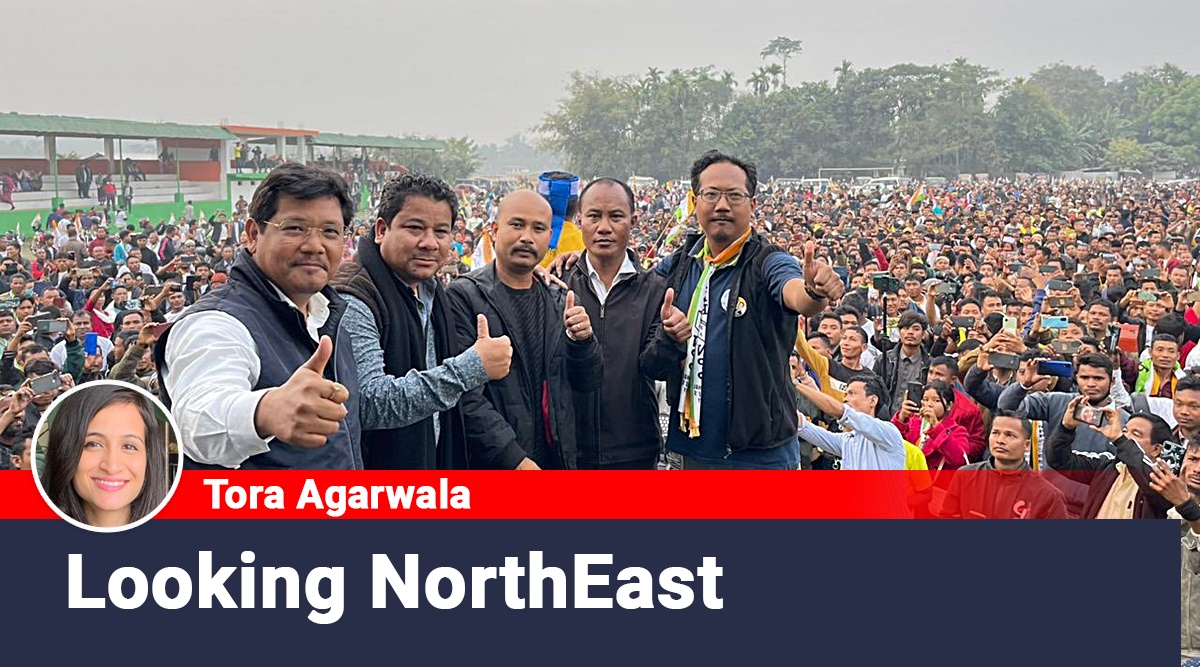
As Meghalaya heads for Assembly elections on February 27, almost all political parties are candid about being open to post-poll possibilities. It is only natural – given that coalition governments are somewhat of a norm in the hill state.
At the heart of it, observers say, is the sheer number of regional parties that dot the electoral landscape in the state. Mostly known by their acronyms, many disintegrate as quickly as they are formed, often months before an election.
In 2018, for instance, as many as seven-state based parties – apart from the ruling National People’s Party (NPP), which now has footprints in several other states of the region, too – contested the election. Together, they accounted for a formidable 13 seats and nearly 30 per cent vote share in the 60-seater Assembly.
These parties included the United Democratic Party (UDP), which won 6 seats, the People’s Democratic Front (PDF), which got 4 constituencies, the Hill State People’s Democratic Party (HSPDP), which won 2 seats, and the Khun Hynniewtrep National Awakening Movement (KHNAM), that cornered 1 seat.
Subscriber Only Stories
In 2013, six regional parties were in the fray, in a more one-sided election by the state’s standards. However, they still accounted for nearly 25 per cent share of votes, and 14 seats.
Ditto in 2008: five Meghalaya-based parties snared 30 per cent of the vote share and 17 seats. That year, they also formed a short-lived government.
What explains this wide proliferation of small parties in the state, particularly when compared to the other tribal states in the region where fewer regional electoral forces exist?
Advertisement
“Meghalaya’s politics are drawn along the lines of a certain community so almost every area, every district has its own contending political interests,” says Avner Pariat, a Khasi writer who is himself contesting this time on the ticket of the newly formed Voice of the People Party (VPP).
Pariat adds: “People always feel that we can’t fight for our issues unless we are in the government. So that’s why a lot of vested interests end up becoming political parties. In Meghalaya, even the tiniest of the tiny can capture power. And that is actually a good thing, in my opinion.”
Consider the Public Demands Implementation Convention (PDIC), a party that began life in 1977 primarily focusing on the interests of farmers, especially those growing potatoes in the Khyrim area of the Khasi Hills.
Advertisement
KHNAM was a student organisation before it converted into a political party. Its former president was Paul Lyngdoh, a former Khasi Students’ Union leader. Lyngdoh subsequently parted ways and floated a regional group of his own, calling it KHNAM (Paul Lyngdoh). In 2011, the party merged with the United Democratic Party (UDP), and in 2014, Lyngdoh became the UDP’s president.
Samrat Choudhury, a political commentator and author from the state, says a possible reason for the abundance of parties is “the low entry barrier”. “The size of constituencies in the state is small, and anyone who can garner around 10,000 votes can win from a lot of constituencies,” he points out, adding that in the past when populations were lower, around 2,000 votes were enough to win in many seats.
“That’s comparable to the number of votes required to win a municipal ward in cities in mainland India. This means that the potential cost of contesting is low enough to be affordable,” Choudhury says, adding that conflicting ambitions lead powerful local politicians to jump into the fray.
He also points out that most of these small parties are based in the state’s Khasi Hills. “As identity politics thrives, these parties come up claiming to represent local Khasi aspirations,” he says.
Renikton Tongkhar, who is contesting on the ticket of the UDP, the most influential of the regional parties, seems to agree. “People have different thoughts, views, ideas,” he said. “Even if there are small differences, instead of sitting together, they form a new party.”
Advertisement
This often means a hostile relationship among these parties, which mostly prevents them from banding together despite their invariably formidable combined vote share. Instead, more often than not, they end up becoming kingmakers for larger national parties.
The two exceptions have been governments formed in Meghalaya of entirely these small regional parties, in 1998 and 2008. However, both lasted only briefly.
Advertisement
Patricia Mukhim, Editor of the Shillong Times, says: “These are opportunistic parties and come up largely because in the Khasi-Jaintia Hills people want to be in a leadership position and do not work well together. Everyone is a leader. It’s also very ego-based, and naturally such parties tend to disintegrate after elections.”
Political commentator and retired bureaucrat Toki Blah concurs. “The irony is that there are a plethora of political parties but there is no concept of party politics,” he says. “Meghalaya elections remain entirely personality-based.”
"crowded" - Google News
February 02, 2023 at 09:19PM
https://ift.tt/SuZDOrQ
It’s once again crowded in Meghalaya, and no one’s complaining - The Indian Express
"crowded" - Google News
https://ift.tt/goaKYQ7
https://ift.tt/nwAlcP2
Bagikan Berita Ini

















0 Response to "It’s once again crowded in Meghalaya, and no one’s complaining - The Indian Express"
Post a Comment